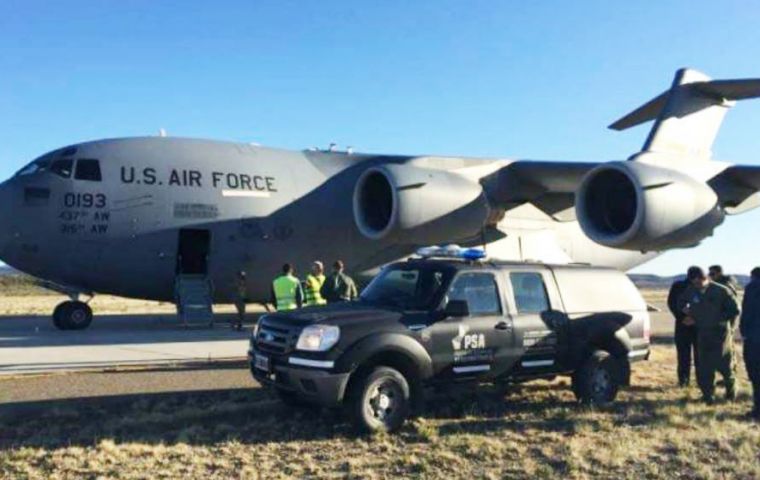MercoPress. South Atlantic News Agency
US Navy sending deep-sea rescue equipment to assist in search for ARA San Juan
 The San Diego based Undersea Rescue Command (URC) departed with a Submarine Rescue Chamber (SRC) and four aircraft
The San Diego based Undersea Rescue Command (URC) departed with a Submarine Rescue Chamber (SRC) and four aircraft The United States Navy has sent rescue equipment and crew to assist in the search for a missing Argentine Navy submarine and its 44 crew members. The San Diego based Undersea Rescue Command (URC) departed from Miramar Saturday with a Submarine Rescue Chamber (SRC) and four aircraft, en route to the Southern Atlantic, where the submarine A.R.A. San Juan lost contact with the Argentine Navy on Wednesday.
The U.S. Navy deployed its sailors after the government of Argentina asked for international assistance in the search. The Argentine Foreign Ministry said in a statement that the governments of Britain, Brazil, Uruguay, Peru, South Afirca and Chile had also offered “logistical help and an exchange of information for this humanitarian search.”
On Saturday, Argentina said it detected seven brief satellite calls that officials believe may have come from the missing submarine, though the origin of the calls could not be confirmed.
URC sailors will join the Navy’s P-8A Poseidon maritime aircraft’s 21-person crew and a NASA research aircraft, both already aiding the search off Argentine's southern Atlantic coast.
The US Navy’s submarine rescue vessel is able to reach depths of 850 feet and rescue six people at a time by using advanced technology in submarine rescue scenarios, according to U.S. Navy Southern Command.
Poseidon’s sensors are equipped to conduct search-and-rescue missions from the sky, as its sensors search below the surface of large bodies of water.
A second rescue system, the Pressurized Rescue Model (PRM) is scheduled to arrive in the South Atlantic early next week. The PRM can reach depths of 2,000 feet and is able to rescue 16 people at a time, the U.S. Navy said.
A storm on Sunday complicated efforts to find an Argentine navy submarine missing in the South Atlantic with 44 crew members, while satellite calls thought to come from the vessel did not help searchers identify the vessel’s location.
The defense ministry has said the ARA San Juan appeared to try to make contact through seven failed satellite calls on Saturday between late morning and early afternoon. The vessel was 432 km off Argentina’s coast when its location was last known early on Wednesday.
As waves of up to 8 meters and winds reaching 40 knots complicated the search by sea, authorities spent Sunday trying to trace the submarine’s location through data from the satellite calls without significant progress, a navy official told reporters.
“We analyzed these signals, which as we know were intermittent and weak,” said Gabriel Galeazzi, a naval commander. “They could not help determine a point on the map to help the search.”
U.S. satellite communications company Iridium Communications Inc, which was brought in to help analyze the calls, said they did not originate with its device aboard the vessel and may have been from another satellite communications company’s equipment.
More than a dozen boats and aircraft from Argentina, the United States, Britain, Chile and Brazil had joined the effort. Authorities have mainly been scanning the sea from above as the storm made the search difficult for boats, navy Admiral Gabriel Gonzalez told reporters.
“Unfortunately these conditions are expected to remain for the next 48 hours,” Gonzalez said from the Mar del Plata naval base, about 420 km south of Buenos Aires where the submarine had been heading toward before vanishing.




Top Comments
Disclaimer & comment rulesCommenting for this story is now closed.
If you have a Facebook account, become a fan and comment on our Facebook Page!